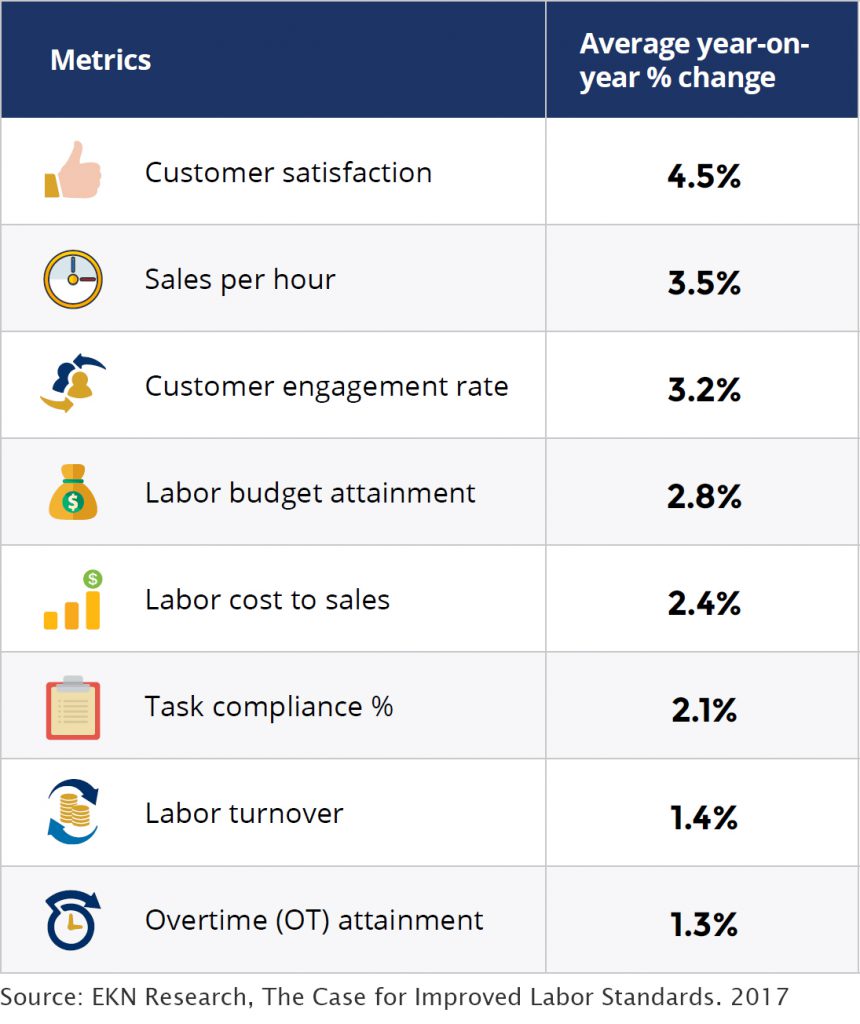One of the questions I frequently get asked by prospective clients is “what is the ROI on new labor standards”? In other words, “how can I justify an investment in a new or updated labor model?”
While I can talk about the benefits of labor standards and provide anecdotes from other companies, there has been no study or research to point to…well, there was no study until now. EKN Research has released “The Case for Improved Labor Standards” which summarizes its study that examined at how retailers use labor standards and the benefits they receive from them.
As part of its study, EKN asked a group of retailers what year-over-year change did they see as a result of effective labor standards? The response was pretty impressive. Retailers cited improvement in eight performance metrics following a labor standards initiative as illustrated in the table below.

Looking at the results, the measurable benefits from labor standards fall into four areas:
- Customers receive better service. EKN found that effective labor standards helped increase customer engagement rates by 3.2 percent which drove a 4.5 percent improvement in customer satisfaction. This may be surprising for people that think about labor standards as being task-oriented rather that service- or sales-oriented. But, service standards are a critical part of any retail labor model. Service standards ensure that associates are provided with enough time with customer and the EKN findings certainly show that effective labor standards include both task and service standards.
- Associates sell more. Retailers reported a 3.5 percent increase in sales per labor hour and a 2.4 percent reduction in labor cost to sales. These results really go hand in hand and are consistent with the results Axsium Group sees in the field: when associates have time to engage with customers, conversion rates and transaction values increase. This means that effective labor standards give retailers a powerful path to improve sales productivity.
- Sh!t gets done. Labor standards ensure that non-selling tasks get done. Retailers improved task compliance by 2.1 percent when using standards effectively. Labor standards help retailers allocate the right amount of time to take care of non-selling tasks while still providing the right amount of customer service (as evidenced in the first point).
- Labor costs are contained. Prospective clients often worry that labor standards and their bottoms-up approach to labor forecasting are going to show that their stores are being underfunded. In fact, a labor standards project rarely increase budget. Instead, they better allocate budget between departments and/or stores. EKN’s research back this up. It found that retailers with an effective labor standards program improved their ability to hit their labor budget by 2.8 percent and reduced overtime by 1.8 percent.
There is no doubt that labor standards can deliver big benefits to retailers. The most interesting thing is that the benefits of labor standards are cumulative. If give your associates enough time for tasks, they not only increase task compliance but have the enough time to service your customers. If you give your associates enough time for service, they increase conversion and basket size which increases sales. If you give your associates enough time for selling and non-selling tasks, they reduce your labor costs. Powerful stuff.


